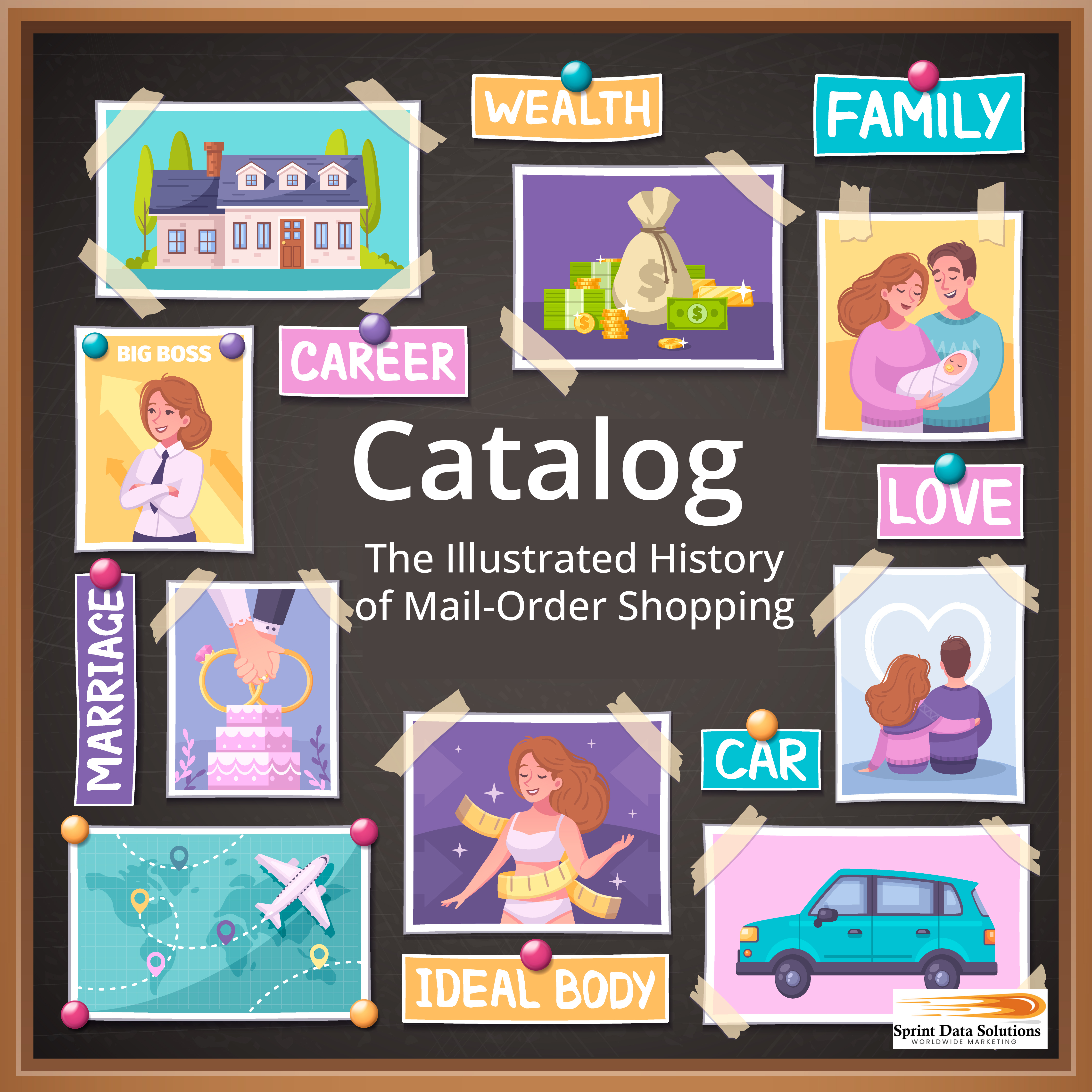Catalog & Magazine Mailing List
The 21st century has brought about a dramatic transformation in how people engage in everyday activities, with shopping being a prime example. What was once a routine, in-person experience—whether at local markets, department stores, or sprawling shopping malls—has largely shifted to the digital domain. Today’s consumers, both in the United States and globally, enjoy the convenience of browsing and purchasing products through e-commerce platforms, often from the comfort of their homes. Yet, despite this digital revolution, one traditional format has managed to endure and even thrive: the catalog. Far from being obsolete, catalogs continue to play a strategic role in modern marketing, appealing to a wide demographic, particularly those who appreciate the tactile experience of flipping through pages or prefer curated selections that highlight seasonal or thematic offerings. In both print and digital formats, catalogs not only serve as visually engaging tools for showcasing products but also influence how e-commerce websites are structured, often mirroring catalog layouts for intuitive navigation. This blend of nostalgia and effectiveness keeps catalogs relevant in today’s omnichannel marketing strategies. For businesses aiming to tap into this powerful medium and reach consumers who respond to catalog and magazine-based outreach, Sprint Data Solutions Worldwide Marketing offers expert guidance and targeted data solutions to ensure impactful and measurable results.
The Sprint Data Solutions Worldwide Marketing Story
Sprint Data Solutions Worldwide Marketing is a proudly American-owned enterprise founded and operated by a disabled veteran. Following a dedicated period of service defending the United States, the founder chose to transition from protecting the nation to fostering its economic prosperity by empowering businesses across the country. This vision gave birth to Sprint Data Solutions Worldwide Marketing—a company rooted in patriotic values and a commitment to supporting American enterprises. Headquartered in Las Vegas, Nevada, the company began with a local focus but was driven by a mission for nationwide and eventually international impact. Today, the firm is backed by a team of seasoned professionals whose combined expertise in marketing and sales spans over half a century, bringing a wealth of knowledge and proven strategies to every client engagement.
In its early days, the marketing industry was heavily reliant on traditional media formats, such as print, radio, and television. Sprint Data Solutions chose to carve a niche in direct mail marketing—a personalized, targeted approach that has remained a reliable cornerstone of customer outreach. While many companies moved hastily into digital channels, Sprint Data Solutions never abandoned the power of print. Instead, it enhanced and refined direct mail strategies, making them more data-driven and efficient. As the market evolved, the company evolved with it, integrating robust digital marketing services to offer clients a full spectrum of outreach tools, from email and social media to SEO and programmatic advertising.
The company’s consistent success has fueled a remarkable expansion trajectory. From its initial footprint in Las Vegas, it soon covered all of Nevada, then extended services across the continental United States—including Alaska and Hawaii. With this nationwide presence established, the company ventured into North America at large, successfully reaching businesses and consumers in Canada and Mexico. Recognizing the increasing demand for international connectivity, Sprint Data Solutions broadened its reach across the Atlantic, enabling American clients to tap into key global markets, including the lucrative European Union, with countries such as France among the primary destinations. Through it all, the company has maintained its core principle: delivering precise, data-informed marketing strategies that generate measurable results. Whether through traditional direct mail or cutting-edge digital solutions, Sprint Data Solutions Worldwide Marketing continues to serve as a catalyst for growth—for small businesses and large enterprises alike.

The Catalog & Magazine Advantage
Despite the rapid shift to digital platforms, physical catalogs and magazines continue to maintain a unique and enduring appeal. These tangible forms of media offer a sensory experience—texture, layout, imagery, and design—that digital interfaces often struggle to replicate. Rather than being rendered obsolete by online shopping, catalogs have evolved into powerful complementary tools that blend traditional marketing with digital convenience. In the pre-digital era, ordering from a catalog meant filling out a physical form, mailing it in, or visiting a retail outlet, with occasional phone orders supplementing the process. Today, however, printed catalogs are often integrated seamlessly with online platforms, allowing readers to enjoy a relaxed browsing experience before quickly placing an order via smartphone, tablet, or desktop.
Magazines offer a similarly irreplaceable experience, especially when executed with high editorial and design standards. Unlike web pages that may suffer from ad clutter, distractions, or low-quality visuals, well-crafted magazines stand out through their curated content and polished presentation. They command attention in a way digital formats often can’t, and they provide a more immersive and focused reading experience without the need for internet access.
For businesses, this blend of traditional and digital media provides a strategic advantage. Catalogs and magazines can bypass the overcrowded and often ignored email inbox, delivering impactful messaging straight into the hands of the consumer. This approach is especially effective for companies in industries like fashion, luxury goods, home furnishings, specialty foods, and niche collectibles, where aesthetics and detailed product presentation influence purchasing decisions. When paired with modern order options—like QR codes, short URLs, or call-in numbers—these print materials not only boost engagement but also drive conversions, offering a powerful bridge between physical charm and digital efficiency.
Home Cooking Magazines
The COVID-19 pandemic brought significant shifts in lifestyle, particularly in how people approach dining. One of the most notable changes was a reduction in eating out, driven by health concerns, lockdowns, and financial uncertainty. Even as the pandemic has gradually receded and restaurants have reopened, many individuals and families continue to prioritize cooking at home as a more economical and sustainable option for managing their monthly expenses. Beyond budgeting, home cooking has grown in popularity due to its health benefits, creative satisfaction, and the ability to control ingredients and portion sizes. In this context, cooking magazines have experienced a resurgence in value—not just as sources of reliable and diverse recipes, but also as practical kitchen companions. Unlike smartphones or tablets, which can be disruptive or prone to damage from spills and splatters, physical magazines are safer, easier to navigate while cooking, and don’t require constant charging or updates. They also offer beautiful photography, curated content, and tips that inspire cooks of all skill levels. As a result, cooking magazines remain a trusted and tactile tool for those who have embraced home-cooked meals as a staple of daily life.
Fine Wines
Wine represents more than just a beverage—it embodies culture, history, lifestyle, and, for some, a strategic investment. It captivates enthusiasts across the globe, ranging from casual sippers to seasoned collectors who view wine as a reflection of sophistication and personal taste. Because of this deep-rooted passion, wine-focused publications—whether magazines, catalogs, or digital platforms—remain highly relevant among wine aficionados. These audiences expect more than enticing visuals; they seek content rich in expertise, covering everything from tasting notes and food pairings to vineyard practices and regional histories. Effective wine marketing must cater to a wide spectrum of consumers, offering entry-level table wines that suit everyday enjoyment, premium vintages that reflect award-winning craftsmanship, and rare, celebratory selections like late harvest or ice wines that commemorate special moments. The diversity and heritage of wine make it uniquely suited for editorial exploration, allowing publications to delve into centuries-old traditions, spotlight up-and-coming winemakers, dissect global market trends, and share stories that resonate with connoisseurs and newcomers alike. As such, wine media serves not only as a showcase of products but as a vital cultural bridge that connects readers to the timeless, evolving world of wine.

Cigars
Much like fine wine, cigars have long been regarded as a symbol of sophistication, indulgence, and leisure. They are not merely tobacco products but cultural artifacts steeped in history, craftsmanship, and tradition. The appreciation for cigars is often a refined, acquired taste, nurtured over time through experience and exploration. While modern health warnings continue to shape public perception, the cigar-smoking community remains strong, built around ritual, luxury, and connoisseurship. Unlike cigarettes, cigars are generally enjoyed on rarer occasions, often in celebratory or contemplative settings, and with a focus on flavor, aroma, and origin. As consumable goods, cigars have a natural cycle of usage and replenishment, making them ideal for repeat engagement and brand loyalty. Just as wine lovers seek out unique vintages or varietals, cigar enthusiasts are often eager to explore different blends, wrappers, and regions of production. Therefore, compelling presentation, strategic marketing, and informative content—such as tasting notes, pairing suggestions, and educational materials—can significantly influence purchasing decisions. When thoughtfully targeted to discerning audiences, these efforts not only highlight the premium qualities of specific cigars but also foster deeper customer engagement and long-term brand affinity.
Household Goods
Running a household efficiently requires a wide array of essential products and supplies, ranging from everyday cleaning agents like dishwashing liquid and laundry detergent to personal care items such as toilet paper and soap. Seasonal needs also come into play, such as rock salt for icy walkways in the winter or insect repellents during warmer months. Each room in a home—from the kitchen to the bathroom, garage to the garden—has its own set of necessities to maintain cleanliness, comfort, and safety. Comprehensive catalogs serve as practical tools for sourcing these products, offering everything from basic household goods to specialized equipment or services like HVAC maintenance or home organization solutions. Meanwhile, home and lifestyle magazines not only highlight top-rated or innovative products but also offer expert tips, DIY hacks, and maintenance strategies that help homeowners make informed decisions and improve the overall functionality of their living spaces. Together, these resources provide valuable guidance for managing the complex, ongoing demands of home upkeep.
Children’s Products
The market for children’s products has always been large and expansive, ranging from educational products and services to nutrition and entertainment. Catalogs for children’s products can be equally diverse. However, this is where children’s magazines can come into their own. Parents are always receptive to new ideas and products that can improve the child-rearing experience.
CBD Oil & CBD Creams
As legislation across the United States continues to evolve, the legal landscape for cannabis and its derivatives is undergoing rapid transformation. Among these, cannabidiol (CBD), a non-intoxicating compound derived from the cannabis plant, has gained widespread attention for its therapeutic benefits. Unlike THC, the psychoactive element in cannabis, CBD does not produce a “high,” making it an attractive option for individuals seeking relief without altered mental states. Scientific studies and anecdotal evidence alike highlight CBD’s efficacy in managing a wide range of conditions, including chronic stress, inflammation, pain, anxiety, and digestive disturbances—benefiting not only humans but also pets, especially dogs and cats dealing with age-related ailments or anxiety.
The rising popularity of CBD has spurred diverse product development, ranging from oils and tinctures to topical creams, edibles, and capsules. This expansion in product variety underscores the importance of targeted marketing strategies. For instance, senior citizens increasingly turn to CBD oil for joint pain, arthritis, and sleep disorders, whereas athletes are more likely to seek rapid recovery options such as CBD-infused balms and muscle rubs. These distinct consumer profiles demand differentiated content strategies across platforms like magazines and product catalogs. Effective outreach requires not only compelling storytelling and testimonials but also educational content that demystifies CBD’s health benefits, safety profile, dosage guidelines, and legal considerations. Tailoring messages to the needs, concerns, and lifestyles of specific demographics is essential for building trust and driving engagement in this fast-growing wellness sector.
Sports Magazines & Products
For decades, sports have commanded a passionate following, with magazines dedicated to covering every facet of athletic competition, from detailed play-by-play analyses to in-depth athlete profiles and behind-the-scenes coverage of training, strategy, and personal journeys. This hunger for rich, nuanced sports journalism persists across all disciplines—be it globally celebrated sports like soccer and basketball or more specialized pursuits such as curling or bobsledding. Enthusiasts crave expert insights and engaging storytelling that goes beyond what brief news coverage can offer. At the same time, the demand for quality sporting goods remains evergreen. Whether it’s high-performance gear for professional athletes or reliable equipment for amateur players, the need for accurate, well-organized catalogs and product magazines is essential. These publications must not only showcase relevant products tailored to each sport but also resonate with the interests and preferences of their target audiences. Aligning the right editorial content and merchandise with the correct sports communities—through thoughtful curation and strategic distribution—remains a key factor in meeting the market’s expectations and maintaining customer loyalty.
Seeds & Plants
Gardening has long been a beloved aspect of American home life, offering not just beauty and relaxation but also practical benefits. In recent years, there’s been a significant resurgence of interest in gardening, driven by growing awareness of environmental sustainability, a desire for healthier lifestyles, and the potential for saving money by growing one’s own food. As a result, the demand for seeds and plants has surged among a diverse range of consumers—from beginners taking their first steps in home gardening to seasoned enthusiasts seeking specialized, high-yield varieties or eco-friendly cultivation techniques.
This renewed enthusiasm has opened the door for a wide array of products and services. These include organic and heirloom seeds, starter kits for urban gardening, hydroponic and aquaponic systems, composting supplies, and educational resources such as online tutorials and workshops. Additionally, many suppliers now offer subscription boxes, custom planting plans, and even virtual consultations to support gardeners at every skill level. Whether for enhancing food security, reducing carbon footprints, or simply enjoying a rewarding hobby, gardening continues to flourish as a valuable and accessible pursuit for millions across the country.
Collectibles
A substantial and highly valuable segment of the consumer market is composed of passionate collectors—individuals with deep-rooted interests in specific types of collectibles. However, this demographic is far from uniform. There are sharp distinctions between the preferences, motivations, and purchasing behaviors across different collector niches. For instance, the dedicated philatelist, focused on acquiring rare or historic postage stamps, exhibits vastly different interests from a vinyl record enthusiast who might pursue both contemporary limited pressings and vintage albums with equal fervor. In turn, both of these groups diverge significantly from retro gamers, whose attention is geared toward nostalgic video game consoles, cartridges, and accessories predominantly from the 1980s and 1990s.
Given these variations, marketing materials such as catalogs and specialty magazines must cater to the unique passions of each collector type with precision. Generalized or unrelated content can alienate rather than engage; a stamp collector is unlikely to find relevance in retro gaming content, just as a vinyl enthusiast will likely overlook promotions targeted at philatelists. Yet, when promotional efforts are tailored and relevant—offering specialized inventory, in-depth features, or exclusive deals—these collectors are among the most responsive and loyal customers. Their engagement levels often translate into repeat purchases, brand loyalty, and word-of-mouth promotion, making them an especially potent audience when addressed with the right, highly targeted content.

Clothing & Fashion
Clothing continues to play a pivotal role in consumer purchases and has maintained its importance in catalog and mail-order sales for decades. In the digital era, this trend persists, with apparel making up a significant share of both print and online retail transactions—especially among Sprint Data Catalog Mail Order buyers and responders who actively seek shopping experiences. The diversity of clothing preferences is vast and closely tied to customer lifestyles and functional needs. For instance, while casualwear and trend-driven pieces appeal to fashion-forward buyers, professional and workwear items are often chosen for their longevity, functionality, and performance under daily use rather than mere aesthetic appeal.
What remains constant across all types of clothing sales is the power of visual impact. High-quality, thoughtfully styled images can dramatically elevate the perceived value of apparel, making photography a key investment for any successful catalog or e-commerce platform. Whether highlighting a garment’s texture, fit, or versatility, effective imagery draws attention and influences purchasing decisions. Additionally, pairing these visuals with well-written, informative content—be it about the materials used, styling tips, or performance features—can significantly boost engagement and conversion rates. Ultimately, clothing remains a dependable and lucrative product category when marketed with attention to both visual storytelling and customer relevance.
Home Improvement
While hiring professionals often ensures high-quality outcomes in home improvement and renovation projects, it can also represent a substantial financial commitment. This cost factor is one reason why the “Do It Yourself” (DIY) approach remains a compelling and popular option for many homeowners. For businesses involved in the home improvement sector—whether they sell tools, materials, or offer related services—direct engagement with the end consumer presents a valuable opportunity. Consumers who opt for DIY solutions often actively seek products, guidance, and inspiration, making them a highly targeted and responsive market segment. From small fixes like replacing a faucet or repainting walls to larger undertakings such as full kitchen renovations, bathroom additions, or even structural repairs, homeowners continuously find reasons to upgrade their living spaces. These improvements not only enhance daily living but can also significantly increase a property’s market value when executed well. As a result, the home improvement industry remains dynamic and expansive, encompassing everything from aesthetic updates to essential structural enhancements—offering plenty of avenues for strategic marketing and customer outreach.
Precision Marketing
The primary determinant of success in catalog, magazine, or other traditional print marketing campaigns is not flashy design or even compelling offers—it’s setting and pursuing a realistic response rate. While marketers may dream of every recipient placing an order, the reality is that a 100% response rate is virtually impossible. However, smart targeting strategies can significantly increase the chances of engagement and eventual conversion. One of the most common mistakes in print marketing is the temptation to pursue mass outreach. While it may seem impressive to blast a million catalogs across the country, this approach often results in a dismal return on investment. This is because broad mailings frequently reach audiences with no interest or need for the product, leading to wasted effort and budget.
Take, for example, a business selling children’s toys and clothing. If this business distributes catalogs to a general mailing list, including large portions of single, childless individuals—such as college students—the likelihood of generating meaningful responses is drastically reduced. This demographic simply has no use for the products, no matter how well the catalog is designed. On the other hand, if the business targets a smaller but precisely defined audience, such as households known to have children aged 2 to 10, the response rate can be significantly higher. Even if the list only contains 10,000 names, the increased relevance of the marketing materials to the recipient often results in more engagement and better ROI. This principle underscores a critical truth: in direct mail marketing, relevance trumps reach. Precision-targeted campaigns focused on a niche, high-interest audience will consistently outperform broader campaigns that rely on sheer volume. Ultimately, successful print marketing isn’t about reaching the most people—it’s about reaching the right people.
We’re Here To Help
Over time, Sprint Data Solutions Worldwide Marketing has developed and curated extensive consumer and business-to-business (B2B) databases designed to meet a wide range of marketing objectives. This has involved not only the accumulation of large volumes of data but also the implementation of rigorous maintenance protocols to ensure that the data remains accurate, relevant, and free from outdated or ineffective contacts. For example, careful cross-referencing and verification processes help avoid common pitfalls such as delivering communications to deceased individuals, incorrect professional targets, or outdated locations. Today, as the marketing landscape continues to evolve, the scope of contact information has expanded significantly beyond traditional postal addresses. Sprint Data Solutions is well-positioned to support modern multichannel marketing strategies, incorporating verified telephone numbers for voice outreach, responsive email addresses for digital campaigns, and mobile numbers optimized for SMS/text message promotions. This comprehensive, up-to-date contact infrastructure ensures that marketing efforts are not only more targeted and efficient but also adaptive to changing consumer preferences and technological trends.
Find The Right List For You
Whether your business is seeking a comprehensive mailing list of catalog and magazine buyers, catalog shoppers, or mail-order purchasers, Sprint Data Solutions Worldwide Marketing offers robust, high-quality data solutions tailored to meet a wide range of marketing objectives. Our databases are meticulously categorized and organized to serve both consumer and B2B outreach strategies, ensuring that clients can precisely target the right audience segments. From a geographical perspective, our listings are highly scalable—clients can execute nationwide campaigns or drill down to regional markets, such as targeting catalog buyers solely in the New England area. We also support hyperlocal marketing efforts with lists that can narrow down to individual states, cities, towns, or even specific neighborhoods, providing an unmatched level of granularity ideal for localized advertising initiatives. In addition to geographic precision, we offer highly refined demographic segmentation based on a diverse range of profile attributes. These include but are not limited to age, gender, income bracket, purchasing behavior, and lifestyle interests. All of our databases are rigorously maintained, verified, and updated on a regular basis to ensure that the contact information remains current and actionable. At Sprint Data Solutions Worldwide Marketing, our commitment to data integrity and relevance empowers clients to optimize their outreach efforts with confidence and precision.
- Age
- Ethnicity
- Debt
- Age of Children
- Renter
- Homeowner
- Income
- Marital Status
- Mortgage Data
- Geography
- Veteran Status
- Big & Tall Mail Order Buyers
At Sprint Data Solutions Worldwide Marketing, we understand that successful marketing hinges on reaching the right audience with precision and impact. That’s why we offer tailored catalog and magazine direct mail lists designed to meet the unique needs of your campaign—whether you’re aiming to connect with a broad demographic or a highly specialized niche market. Our databases are meticulously compiled and continually updated to ensure optimal deliverability and engagement. With access to millions of consumer and business records categorized by key criteria such as age, income, purchasing behavior, geographic location, and interests, we empower your marketing efforts to resonate with the most responsive recipients. Let us help you maximize your outreach and ROI—partner with Sprint Data Solutions and put your catalogs and magazines in the hands of those who matter most.






